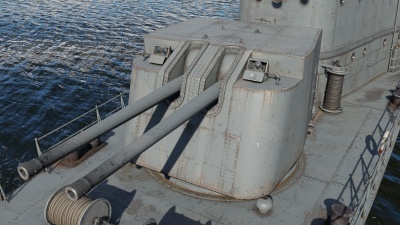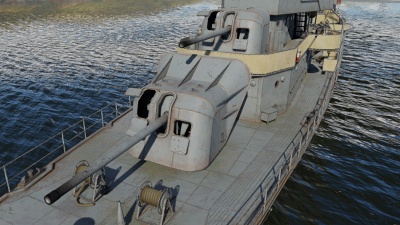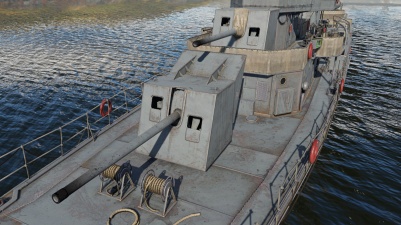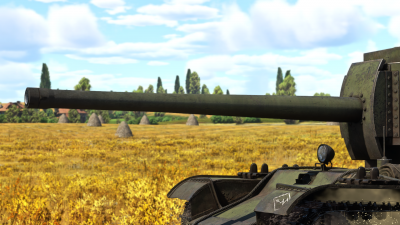Difference between revisions of "B-13 (130 mm)"
Colok76286 (talk | contribs) (Edits) |
Colok76286 (talk | contribs) (→Vehicles equipped with this weapon: Edits) |
||
| (3 intermediate revisions by 3 users not shown) | |||
| Line 1: | Line 1: | ||
| + | [[File:B-13 on Project 30bis destroyer.png|thumb|x250px|130 mm B-13 on the [[Bezuprechny]]]] | ||
| + | |||
== Description == | == Description == | ||
<!-- ''Write an introduction to the article in 2-3 small paragraphs. Briefly tell us about the history of the development and combat using the weaponry and also about its features. Compile a list of air, ground, or naval vehicles that feature this weapon system in the game.'' --> | <!-- ''Write an introduction to the article in 2-3 small paragraphs. Briefly tell us about the history of the development and combat using the weaponry and also about its features. Compile a list of air, ground, or naval vehicles that feature this weapon system in the game.'' --> | ||
| Line 5: | Line 7: | ||
=== Vehicles equipped with this weapon === | === Vehicles equipped with this weapon === | ||
<!-- ''List out vehicles that are equipped with the weapon.'' --> | <!-- ''List out vehicles that are equipped with the weapon.'' --> | ||
| − | |||
| − | + | {{Navigation-Start|Vehicles equipped with this weapon}} | |
| + | |||
| + | {{Navigation-First-Line|'''Naval vessels'''}} | ||
| + | |||
| + | {{Navigation-Line|Destroyers}}{{Specs-Link|ussr_destroyer_pr45}}{{-}}{{Specs-Link|ussr_destroyer_7_besposhchadny}}{{-}}{{Specs-Link|ussr_destroyer_7_ryany}}{{-}}{{Specs-Link|ussr_destroyer_7y}}{{-}}{{Specs-Link|ussr_destroyer_7y_stroyny}}{{-}}{{Specs-Link|ussr_destroyer_pr30_ognevoy}}{{-}}{{Specs-Link|ussr_destroyer_pr30bis_bezuprechnyi}}{{-}}{{Specs-Link|ussr_destroyer_pr30bis_smelyi}} | ||
| + | {{Navigation-Line| }}{{Specs-Link|ussr_destroyer_leningrad}}{{-}}{{Specs-Link|ussr_destroyer_moskva}}{{-}}{{Specs-Link|ussr_destroyer_pr20_tashkent}} | ||
| + | |||
| + | {{Navigation-First-Line|'''Ground vehicles'''}} | ||
| − | + | {{Navigation-Line|Tank destroyers}}{{Specs-Link|ussr_su_100Y}} | |
| − | + | {{Navigation-End}} | |
| − | |||
| − | |||
| − | |||
| − | |||
| − | |||
| − | |||
| − | |||
| − | |||
| − | |||
== General info == | == General info == | ||
Latest revision as of 03:02, 5 November 2023
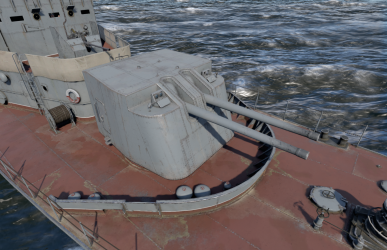
Contents
Description
The 130 mm B-13 is a Soviet naval gun.
Vehicles equipped with this weapon
| Vehicles equipped with this weapon | |
|---|---|
| Naval vessels | |
| Destroyers | Opytny · Besposhchadny · Ryany · Soobrazitelny · Stroyny · Ognevoy · Bezuprechny · Smelyi |
| Leningrad · Moskva · Tashkent | |
| Ground vehicles | |
| Tank destroyers | SU-100Y |
General info
The B-13 cannon is shared by most WWII-era destroyers of the Soviet fleet, and is a very potent weapon. However, the main flaw with this weapon is its absolutely horrid turret rotation speed of 4.2 degrees/second vertically and horizontally. This means that you have to turn the turrets very early to be able to engage effectively. The gun shoots accurately and has a high initial muzzle velocity (870 m/s). Combined with the horrible traverse rate, this means the guns aren't particularly suited for anti-aircraft duties.
Available ammunition
The guns themselves have access to three shell types: the OF-46 high-explosive (HE) shell, the PB-46A semi armour-piercing (SAPBC) shell, and the ZS-46R proximity-fused (HE-VT) shell. Of these weapons, the HE shell is usually the best against enemy destroyers and ships as it packs the most explosive filler, 3.58 kg of it to be exact. The SAPBC shell works better against the occasional cruiser you may encounter, as it packs more penetration capacity (up to 179 mm compared to 36 mm for the HE shell). Finally, the HE-VT shell is good against aircraft as it will explode when close enough to the enemy aircraft, meaning that it doesn't require a direct hit. However, it actually packs less explosive filler than the normal HE shell, which is unusual for any HE-VT shell.
Ground vehicles
| Penetration statistics | |||||||
|---|---|---|---|---|---|---|---|
| Ammunition | Type of warhead |
Penetration @ 0° Angle of Attack (mm) | |||||
| 10 m | 100 m | 500 m | 1,000 m | 1,500 m | 2,000 m | ||
| PB-46A | SAPCBC | 202 | 199 | 190 | 179 | 168 | 158 |
| OF-46 | HE | 36 | 36 | 36 | 36 | 36 | 36 |
| Shell details | ||||||||||||
|---|---|---|---|---|---|---|---|---|---|---|---|---|
| Ammunition | Type of warhead |
Velocity (m/s) |
Projectile mass (kg) |
Fuse delay (m) |
Fuse sensitivity (mm) |
Explosive mass (TNT equivalent) (kg) |
Ricochet | |||||
| 0% | 50% | 100% | ||||||||||
| PB-46A | SAPCBC | 870 | 33.5 | 1.2 | 19 | 2.35 | 48° | 63° | 71° | |||
| OF-46 | HE | 870 | 33.4 | 0 | 0.1 | 3.58 | 79° | 80° | 81° | |||
Naval vessels
| Penetration statistics | |||||||
|---|---|---|---|---|---|---|---|
| Ammunition | Type of warhead |
Penetration @ 0° Angle of Attack (mm) | |||||
| 1,000 m | 2,500 m | 5,000 m | 7,500 m | 10,000 m | 15,000 m | ||
| 130 mm OF-46 HE | HE | 36 | 36 | 36 | 36 | 36 | 36 |
| 130 mm PB-46A SAPBC | SAPCBC | 181 | 156 | 122 | 96 | 77 | 56 |
| 130 mm ZS-46R HE-VT | HE-VT | 26 | 26 | 26 | 26 | 26 | 26 |
| Shell details | ||||||||||||
|---|---|---|---|---|---|---|---|---|---|---|---|---|
| Ammunition | Type of warhead |
Velocity (m/s) |
Projectile mass (kg) |
Fuse delay (s) |
Fuse sensitivity (mm) |
Explosive mass (TNT equivalent) (kg) |
Ricochet | |||||
| 0% | 50% | 100% | ||||||||||
| 130 mm OF-46 HE | HE | 870 | 33.4 | 0 | 0.1 | 3.58 | 79° | 80° | 81° | |||
| 130 mm PB-46A SAPBC | SAPCBC | 870 | 33.5 | 0.01 | 6 | 2.35 | 48° | 63° | 71° | |||
| Proximity-fused shell details | ||||||||||||
|---|---|---|---|---|---|---|---|---|---|---|---|---|
| Ammunition | Type of warhead |
Velocity (m/s) |
Projectile mass (kg) |
Fuse delay (m) |
Fuse sensitivity (mm) |
Arming distance (m) |
Trigger radius (m) |
Explosive mass (TNT equivalent) (kg) |
Ricochet | |||
| 0% | 50% | 100% | ||||||||||
| 130 mm ZS-46R HE-VT | HE-VT | 870 | 33.8 | 0 | 0.1 | 240 | 16 | 2.06 | 79° | 80° | 81° | |
Comparison with analogues
The B-13 has a high initial muzzle velocity (870 m/s compared to 790 m/s for the American 5"/38 guns). However, this comes at the expense of reload speed, as the manually-loaded weapons can only fire at 10 rounds per minute (RPM) with a spaded crew, compared to 22 RPM for the American 5"/38 guns. In fact, this fire rate is slower than everything except for the Japanese and Italian 5" guns, which have a similar fire rate.
Usage in battles
Describe the cannon/machine gun in the game - its distinctive features, tactics of usage against notable opponents. Please don't write a "guide" - do not impose a single point of view, but give the reader food for thought.
Pros and cons
Summarise and briefly evaluate the weaponry in terms of its characteristics and combat effectiveness. Mark pros and cons as a list.
Pros:
Cons:
History
The B-13 was the replacement for the 130 mm/55 pattern 1913 and the main destroyer gun of World War II. The design for a new cannon was originally intended for Soviet submarines and possessed superior ballistic characteristics to the Pattern 1913 it was replacing. Designed by G. N. Rafalovits at the Bolshevik Plant no. 232 in Leningrad, the gun changed multiple times during development. Originally intended to use a wedge lock and fixed ammunition and high barrel pressure, the design was switched to a destroyer weapon when it was found to be too big for the Pravda-class submarines. The design was thus changed to separate ammunition to reduce costs as it was now not needed for a dry-mount weapon. The gun also had the barrel changed to 50 calibres. Due to the changes and delays, it entered service in 1936 but entered production a year before because of the need for these guns.
Taking lessons from World War I, the Leningrad-class destroyer leader was the first ship to mount this cannon. The B-13 was the first mount to use this cannon and was a single-mount cannon with a 13 mm gun shield. The gun was subsequently used on the Minsk, Baku, Tashkent, Gnevnyi, Storozhevoi, and Ognevoy classes along with the one-off Pr. 45 Opitnyi destroyer. The B-13 also found itself on the Shikila and Khasan-class river monitors, and as coastal artillery and railway guns during World War II. With over 1,000 guns built, the B-13 remained in service through the 1970s in the coastal artillery, where it was mounted along the Muravyov-Amursky Peninsula to protect Vladivostok from a potential Chinese attack.
During World War II, it was found that the high barrel pressure give a barrel life of 130 rounds, which meant the barrels would have to be replaced before the gun's magazines. Attempts to fix this issue resulted in three barrel types which all had different grove depths and removable liners instead of a monobloc barrel. The original liners were 1 mm deep but later models were 1.95 mm and later 2.17 mm which were all incompatible with ammunition and range tables which significantly hampered performance and was a logistical nightmare to manage. The breech mechanism was also found to be unreliable. Production ended in 1954, but it would also see service in other nations.
Finland managed to repair five guns left behind by the Soviets in the Battle of Hanko during the Continuation War which served in the coastal defense and railroad gun roles. The Finns nicknamed the gun Nikolajev and used the guns into the 1990s. The Polish Navy got two Skoryy-class destroyers in the late 1950s along with using the B-13 as coastal batteries on the Hel Peninsula. Finally, China got these guns on their Anshan-class (ex-Gnevny-class) destroyers.
Another application of the B-13 was as the weapon mounted on the SU-100Y prototype self-propelled gun. While it was originally planned by the ABTU (Directorate of Armoured Forces) to mount a 152 mm howitzer, the No. 185 Factory instead armed it with the B-13. Intended for use primarily against fortifications, the SU-100Y never entered production due to the end of the Winter War in Finland and the difficulty to transport the large machine by rail. The prototype would see service during the Battle of Moscow during World War II, but the plans for a self-propelled gun against fortifications evolved in a different direction, creating the KV-2 heavy tank.
Media
- Images
Twin-mount B-13 on Ognevoy
Single-mount B-13 on Soobrazitelny
Single-mount B-13 on Bezuprechny
B-13 used on SU-100Y
See also
Links to the articles on the War Thunder Wiki that you think will be useful for the reader, for example:
- reference to the article about the variant of the cannon/machine gun;
- references to approximate analogues by other nations and research trees.
External links
Paste links to sources and external resources, such as:
- topic on the official game forum;
- other literature.
| USSR tank cannons | |
|---|---|
| 20 mm | TNSh |
| 30 mm | 2A42 · 2A72 · AG-30 |
| 45 mm | 20-K |
| 57 mm | AU-220 · Ch-51M · ZIS-2 · ZIS-4 · ZIS-4M |
| 73 mm | 2A28 |
| 76 mm | 1902/30 · 3-K · D-56TS · F-32 · F-34 · F-96 · KT-28 · L-10 · L-11 · ZIS-3 · ZIS-5 |
| 85 mm | D-5S · D-5T · D-58 · D-70 · F-30 · ZIS-S-53 |
| 100 mm | 2A48 · 2A70 · D-10S · D-10T · D-10T2S · D-50 · LB-1 · S-34 |
| 107 mm | ZIS-6 |
| 115 mm | U-5TS |
| 122 mm | A-19 · D-25-44T · D-25S · D-25T · D-25TS · D-30T · D-49 · M-30 · M-62-T2S |
| 125 mm | 2A26 · 2A46 · 2A46M · 2A46M-1 · 2A46M-4 · 2A46M-5 · 2A46MS · 2A75 · D-126 |
| 130 mm | B-13 · C-70 · M-65 |
| 152 mm | 2A33 · LP-83 · M-10T · M-64 · M-69 · ML-20S |
| Foreign: | |
| 37 mm | M5 (USA) |
| 50 mm | KwK L/42 (Germany) |
| 57 mm | 6pdr OQF Mk.III (Britain) · M1 (USA) |
| 75 mm | KwK42 (Germany) · M2 (USA) |
| 76 mm | M1 (USA) |
| 85 mm | Type-62-85-TC (China) |


